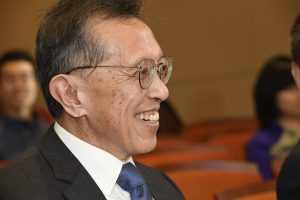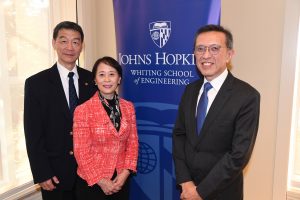For Fadil Santosa, few things are more exciting than collaboration. When it comes to research and partnership to explore new ideas, he describes himself as Dug, the always-enthusiastic golden retriever in Disney-Pixar’s Up.

“I’m very interested in problems that people are working on, and I really want to know how I can contribute to their effort,” he says. “That’s what I felt this new department head position was about. I think applied mathematics should be much more central to everything that happens at Johns Hopkins, both at the research level and at the translation level.”
As the inaugural Yu Wu and Chaomei Chen Department Head in the Whiting School of Engineering’s Department of Applied Mathematics and Statistics (AMS), Santosa is putting his passion for collaboration to work. He arrived in the middle of the COVID-19 pandemic and immediately began reaching out to as many colleagues as he could. In those days, he says, travel restrictions keeping people home and the rise of Zoom meetings made scheduling appointments easy.
“As a result, we have a lot of new collaborations going on between AMS and other units on campus,” Santosa says. “And it’s increasing by the day.”
At Hopkins, Santosa has spearheaded partnerships within the Whiting School and across the institution. Postdoctoral fellows are splitting time between AMS and the SNF Agora Institute, and Santosa is exploring similar opportunities with the School of Medicine and the Ralph S. O’Connor Sustainable Energy Institute (ROSEI).
He’s also conducting his own research with colleagues at the Whiting School and Applied Physics Laboratory, as well as working on projects with collaborators he’s made outside of Hopkins. Prior to his arrival in Baltimore, Santosa spent several months at the ExxonMobil Corporate Strategic Research Lab in New Jersey, which he says was like going to a candy store.
“Everybody was doing some so many interesting things,” he explains. “So I ended up with really a nice set of problems that I’m currently working on.”

One project involves developing a simple mathematical model to better design a device that can capture carbon dioxide directly from the air. Another is exploring optimal experiment design in inverse problems — how to do the fewest number of experiments, which can be complicated and costly, while extracting as much information from those experiments as possible.
“It’s an area that I think has many different applications,” Santosa says. “I’m very excited about this particular work. It could have applications in reducing the amount of radiation a patient is exposed to in imaging, for example.”
He’s also working to develop efficient ways of modeling how light interacts with two-dimensional materials, like those employed in a novel optical device created by a colleague in Minnesota.
“Those are some areas that I’m excited about,” Santosa says. “But like that dog in the movie, I’m always looking around for more interesting things to learn about.”
On campus, Santosa leads Mathematics for a Better World, a class that connects students with a Baltimore-based food bank with the goal of better equipping the organization to serve as many people as possible. In addition, the course, which also involves hands-on experience at the food bank, will help increase his students’ understanding of food insecurity.
“What I think we can bring as applied mathematicians is a way to use data to suggest how the food bank’s founder can better leverage his donors, his delivery, and so on, to scale up his operation,” he explains. One idea is to create a dashboard similar to the Johns Hopkins Coronavirus Resource Center’s COVID-19 map, which collected data through early March of this year. “This will allow the food bank ready access to business analytics, allowing them to make decisions quickly and effectively using quantitative information, rather than just gut feel.”
In his work balancing departmental leadership, research collaboration, and teaching, Santosa says he feels like a catalyst enabling things to happen that otherwise wouldn’t.
“If you think about chemical reactions, if the barrier for chemical reaction is too high, the reaction doesn’t take place. I go in there and I try to make things happen,” he says. “I find what I do very rewarding. In the way of students, you can see their eyes light up when they learn something. When I get other people excited, I’m excited.”
Topics: Faculty and Staff, Fueling Discovery, Whiting School of Engineering